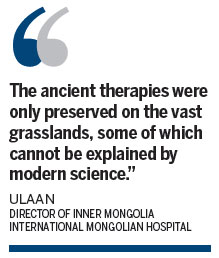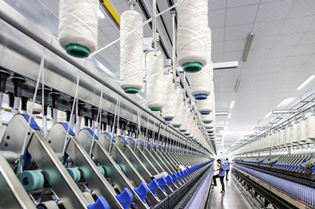Healing traditions go abroad
The practitioners of traditional Mongolian medicine want more people to know about their healers' heritage, and they want to take it abroad.
In February last year, a six-member delegation traveled to the United Nations headquarters in New York and attended an international forum organized by the World Health Organization, where its members delivered a speech on the function and role China's TMM has played in the lives of urban and rural residents.
The delegation was led by Ulaan, director of the State-owned Inner Mongolia International Mongolian Hospital that opened in Hohhot in April 2012. It is currently listed among the country's top hospitals, and almost 400,000 patients were treated in 2013, according to Ulaan.
At the UN, executive director of WHO Jacob Kumaresan applauded the delegation for bringing the first traditional Mongolian medicine from China to the UN podium.
Ulaan attributes this chance to good fortune.
"We were invited because WHO specialists visiting Inner Mongolian were dumbfounded when they saw how our physician put together a leg fracture in seconds," she says. "And I used acupuncture to cure a patient's frozen shoulder right under their eyes. It only cost 16 yuan ($2.60)."
Ulaan estimates that the cost is generally 40 to 50 percent lower as a TMM relies more on the doctor's experience than sophisticated medical instruments and expensive drugs.
"There is too much overuse of antibiotics and hormonal medication. We offer alternative, safer solutions," Ulaan says, proudly recalling the thunderous applause at the UN.
The hospital has begun academic cooperation with laboratories from countries including the United States, the United Kingdom and Japan. It is also getting an increasing number of patients from overseas.

A joint project with the US using psychotherapy and naturopathy for the treatment of psoriasis has achieved significant results, she says.
Psychotherapy included "interactive talking sessions" combined with hypnosis, which seemed to help patients recover from their skin conditions.
"As we gradually establish international fame for Mongolian medicine, many high-level TMM doctors who switched to Western medicine have come back to join us, even some who were working abroad.
"There was no province-level TMM hospital in Inner Mongolia before, and the ancient therapies were only preserved on the vast grasslands, some of which cannot be explained by modern science," she says.
"Once these lose the inheritors, they will probably be forgotten. Now we have a chance to gather the knowledge.
"It's difficult to make Westerners fully understand TMM within a short time, and not everyone has the chance to come and see the unbelievable with their own eyes.
"Those whom we have met have kept open minds toward TMM. Their inclusiveness creates a larger space for more cooperation in the future."
In 2013, the health department of Inner Mongolia reached an agreement with the US National Institutes of Health to promote the study of Mongolian medicine.
Ulaan has a wry last word: "If TMM really went into regular hospitals in the US, they may find their medical expenses plummeting."
wangkaihao@chinadaily.com.cn



 Print
Print Mail
Mail





